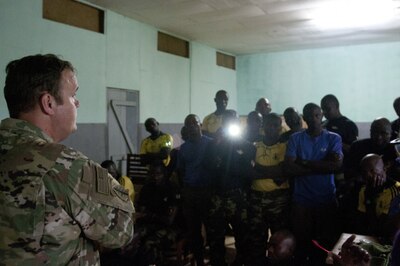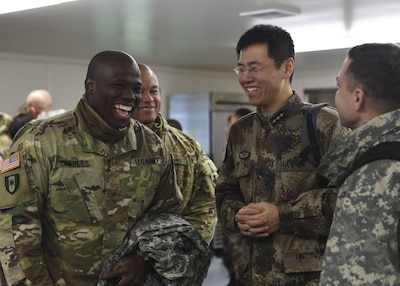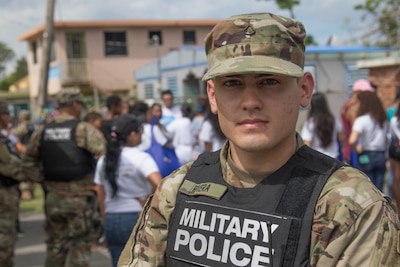By Army Sgt. 1st Class Alexandra Hays U.S. Army Africa
DOUALA, Cameroon, Nov. 24, 2017 — With his uniform shirt
soaked with sweat, Army Staff. Sgt. Joshua Crenshaw calmly halts the
Cameroonian soldier in front of him.
“Stop, you’re dead,” Crenshaw said.
It’s 9 a.m. in Douala, and the humidity is pervasive.
Crenshaw, an explosive ordnance disposal technician and team leader, is
overseeing a practical exercise -- one in which the real-life applications can
mean life or death.
Crenshaw is one of a handful of explosive ordnance disposal
soldiers from the 764th Ordnance Company from Fort Carson, Colorado, who came
to Cameroon at the request of U.S. Army Africa during Counter Improvised
Explosive Device-Defeat Phase I training. The training, held Oct. 23-Nov. 17,
was designed to help Cameroonian troops learn more about IEDs and how to
dispose of them safely.
Terrorists’ Weapon
IEDs are a favorite weapon among terrorist organizations.
Cameroon’s armed forces regularly deploy to northern Cameroon -- an area where
the violent extremist organization Boko Haram operates. According to the United
Nations, attacks by Boko Haram have displaced up to two million people in the
countries of Cameroon, Nigeria, Chad, and Niger, and have claimed the lives of
up to 15,000 people since 2009.
Crenshaw and his team, many with experience countering IEDs
in Iraq and Afghanistan, are deployed here providing potentially lifesaving
training in the fight against violent extremism.
“We’re here passing on the knowledge that will hopefully
save these guys’ lives,” Crenshaw said. “It will make them slow down; make them
think about it before they just run into a situation.”
Crenshaw explained that the students in the course come from
different military departments -- engineers, presidential guard, and the rapid
response brigade -- and have had little to no IED-specific training in the
past.
“We’re trying to help them get ahead of the game -- teach
them how bad it could be, and teach safe methods now,” he said.
Different Types of IEDs
The American soldiers taught the Cameroonian troops the
types of IEDs they might encounter, including vehicle-borne IEDs, suicide
vests, IEDs buried in the ground, weapons caches and more.
“This training is relevant,” Crenshaw said. “When we start
our training we usually ask what the threats are. Their leadership told us that
the big threats they’re seeing are vehicle-borne IEDs and suicide vests.”
Crenshaw said it was rewarding to see the growth in the
students from the first day of the four-week course to graduation.
‘The Training is Essential’
“This training is essential,” said Cameroonian Armed Forces
Maj. Rene Didier Bekada, deputy commandant of the Cameroonian Armed Forces
engineering school. “And it is really the heart of the struggle against groups
who are waging asymmetric warfare [in Cameroon].”
Bekada said the training increased the Cameroonian soldier’s
capacity.
“The U.S. instructors have vast experience … and so during
this training we are really profiting from their experience in counter-IED,” he
said.
Partnering Missions
Army 1st Lt. Jacob Schall, platoon leader for the 764th,
said his team is one of many partnering with militaries in other West African
nations and conducting similar training.
“We come here and we teach them the very basics of IED
defeat … hopefully they can take that expertise and take it to wherever they
are deployed to and help educate their fellow soldiers,” he said.
Schall said he also witnessed clear improvement in the
Cameroonian troops’ counter-IED skills through the training.
“They have a firm grasp of being as safe as possible, which
is the whole point here -- to increase your survivability and freedom of
movement,” Schall said.
This is the first phase of the exercise in fiscal year 2018
-- the 764th team is scheduled to return to Cameroon in the spring to run two
more cycles of the same exercise with new groups of Cameroonian soldiers.
“We’re very concerned about the long-term fight that they’re
going to have,” said Crenshaw, explaining that IED threats become more complex
as extremists gain experience.
“It means a lot to me personally,” Crenshaw said. “I’ve done
the fight; I’ve done what they’re going to do. And I know how dangerous it is.
I’ve been on both sides of the effects of it, so it means everything [to me].”










